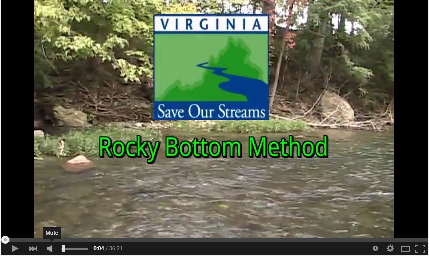VA SOS offers several different online training resources.
Virginia Save Our Streams Rocky Bottom Monitoring Method Demonstration – Provides details and instructions on how to monitor water quality using aquatic macroinvertebrates following a scientifically rigorous protocol accepted by Virginia’s Department of Environmental Quality. This method is best used in streams with riffles, typically found west of the I-95 corridor. This video demonstrates techniques for collecting and identifying aquatic macroinvertebrates, how to complete the data form and determine a water quality ranking, helpful information about safety, sampling equipment, and tips for monitoring. The video also includes an overview of the Izaak Walton League’s Virginia Save Our Streams program.
Part 1 – Introduction – Overview of the Virginia Save Our Streams program and introduction to the Rocky Bottom monitoring method, including where to use the Rocky Bottom method, how to select sites, spacing of multiple monitoring stations on the same stream, and ideal frequency of monitoring.
Part 2 – Macroinvertebrate Sampling and Sorting – Demonstration of macroinvertebrate collection using the rocky bottom method and how to pick macroinvertebrates off the net and sort them into look-alike groups.
Part 3 – Safety and Helpful Monitoring Tips – Description and demonstrations of a variety of stream safety techniques as well as some very helpful tips and things to keep in mind when collecting macroinvertebrates from the stream.
Part 4 – Macroinvertebrate Identification – Detailed information on macroinvertebrate identification including a review of the identifying characteristics of each type of macroinvertebrate included on the VA SOS data form, including photographs and in some cases video footage of each type.
Part 5 – Completing Data Forms and Uploading Data – Step-by-step instructions on how to complete the multi-metric section of the data form, determine a water quality rating, and enter the data to the database at www.vasos.org.
Part 6 – Sampling Equipment and Maintenance – A detailed review of all equipment used for macroinvertebrate collection and identification and tips on how to maintain equipment and keep it in good condition.
Muddy Bottom Stream Monitoring Video – In the video below, Clean Water Program Director Leah Miller walks viewers through the steps for Muddy Bottom stream monitoring in Virginia, including an introduction, sampling methodology, macroinvertebrate identification, data collection and uploading, and equipment requirements. Individual sections of the video are available under the link above.
You can also view this PowerPoint presentation by Mimi Davis.

